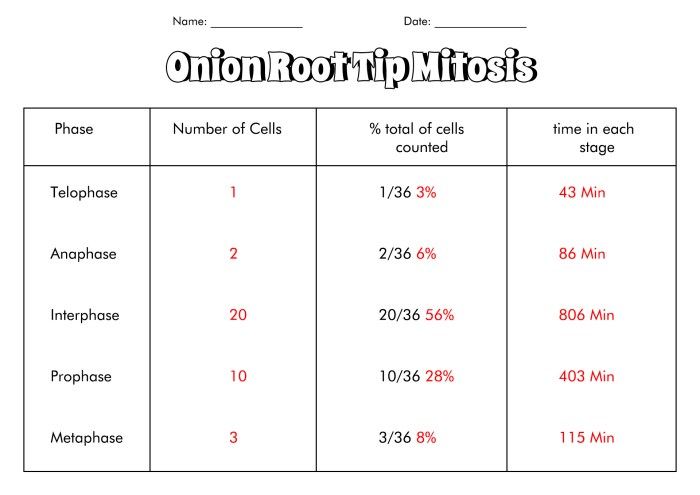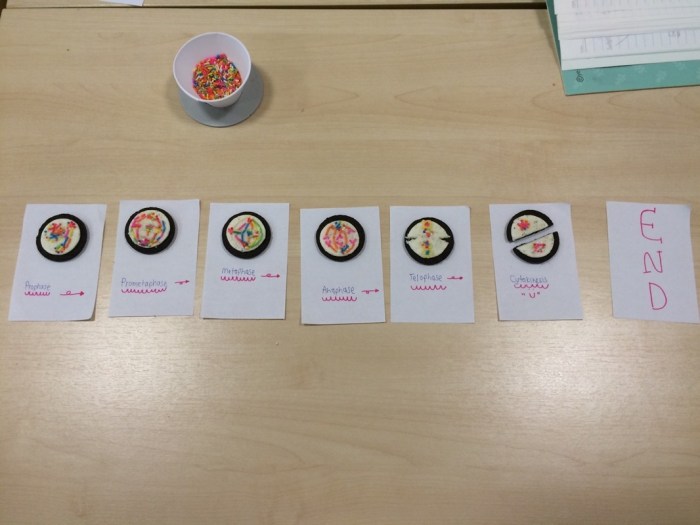Embark on a delicious journey into the fascinating world of cell division with our Oreo Mitosis Lab Answer Key. This engaging guide will unravel the mysteries of mitosis, using the beloved Oreo cookie as a captivating analogy. Get ready to crunch into science and discover the secrets of cell reproduction!
Delve into the stages of mitosis, illustrated with mouthwatering Oreo representations. Understand the key events that drive cell division and witness the remarkable similarities and differences between the Oreo and the real-life process.
Oreo Mitosis Lab
The Oreo Mitosis Lab is a fun and engaging way to learn about the process of mitosis, which is the division of a cell into two identical daughter cells. The lab uses Oreos to represent chromosomes, and students can follow the steps of mitosis as they manipulate the Oreos.
This lab is a great way for students to visualize the process of mitosis and to understand the importance of mitosis in cell division.
Materials
- Oreos
- Toothpicks
- Paper
- Pencils
Procedure
- Draw a diagram of a cell on a piece of paper.
- Use Oreos to represent the chromosomes in the cell.
- Use toothpicks to connect the chromosomes together.
- Divide the cell into two daughter cells by pulling the chromosomes apart.
- Draw a diagram of the two daughter cells.
Mitosis Process
Mitosis is the process by which a cell divides into two identical daughter cells. It is a continuous process, but it can be divided into four distinct stages: prophase, metaphase, anaphase, and telophase.
During prophase, the chromosomes become visible and the nuclear envelope breaks down. The centrosomes, which are responsible for organizing the spindle fibers, begin to move to opposite poles of the cell.
In metaphase, the chromosomes line up in the center of the cell. The spindle fibers attach to the chromosomes and begin to pull them apart.
In anaphase, the chromosomes continue to be pulled apart until they reach opposite poles of the cell. The spindle fibers then break down and the nuclear envelope reforms around each of the two daughter cells.
In telophase, the chromosomes become less visible and the nuclear envelope reforms. The cytoplasm of the cell divides, and two identical daughter cells are formed.
Key Events During Each Stage
- Prophase:Chromosomes become visible, nuclear envelope breaks down, centrosomes move to opposite poles.
- Metaphase:Chromosomes line up in the center of the cell, spindle fibers attach to chromosomes.
- Anaphase:Chromosomes continue to be pulled apart, spindle fibers break down, nuclear envelope reforms around daughter cells.
- Telophase:Chromosomes become less visible, nuclear envelope reforms, cytoplasm divides, two daughter cells are formed.
Oreo Analogy

The Oreo cookie serves as an excellent analogy for the different stages of mitosis. Just like mitosis involves the division of a cell into two identical daughter cells, the Oreo cookie can be separated into two identical halves.
Stages of Mitosis, Oreo mitosis lab answer key
- Prophase:In prophase, the chromatin condenses into visible chromosomes, and the nuclear envelope breaks down. The Oreo cookie can be likened to prophase when the two halves are separated, revealing the white cream filling, which represents the chromosomes.
- Metaphase:During metaphase, the chromosomes line up in the center of the cell. In the Oreo analogy, this stage is represented by the two halves of the cookie being placed side by side, with the cream filling (chromosomes) in the middle.
- Anaphase:In anaphase, the chromosomes are pulled apart to opposite ends of the cell. The Oreo analogy for anaphase is when the two halves of the cookie are pulled apart, separating the cream filling (chromosomes) into two equal parts.
- Telophase:In telophase, two new nuclear envelopes form around the chromosomes, and the cell membrane pinches in the middle, dividing the cell into two daughter cells. In the Oreo analogy, telophase is represented by the two halves of the cookie being completely separated, each with its own cream filling (nucleus).
Similarities and Differences
The Oreo analogy provides a simplified representation of the complex process of mitosis. While it captures the essence of the process, there are some key differences to note:
- Number of cells:Mitosis results in the creation of two daughter cells, while the Oreo analogy only represents one cell.
- Cytokinesis:In mitosis, cytokinesis is the process of dividing the cytoplasm into two daughter cells. The Oreo analogy does not represent this process.
- Chromosomes:In mitosis, chromosomes are made of DNA and are essential for carrying genetic information. The cream filling in the Oreo analogy represents the chromosomes but is not an exact replica.
Despite these differences, the Oreo analogy remains a valuable tool for understanding the basic stages of mitosis.
Lab Observations: Oreo Mitosis Lab Answer Key
During the Oreo Mitosis Lab, students used Oreo cookies to represent the different stages of mitosis. They observed the following:
The table below summarizes the observations made during the lab:
| Stage of Mitosis | Oreo Cookie Representation |
|---|---|
| Interphase | Two intact Oreo cookies |
| Prophase | Two Oreo cookies separated by a cream filling |
| Metaphase | Two Oreo cookies lined up in the center of the plate |
| Anaphase | Two Oreo cookies separated by a large cream filling |
| Telophase | Two intact Oreo cookies, each with its own cream filling |
Lab Analysis

The Oreo Mitosis Lab provided valuable insights into the process of mitosis, showcasing the fundamental principles of cell division in a tangible and engaging manner.
Seeking answers for the oreo mitosis lab? While you’re at it, check out big ideas integrated math 3 for a comprehensive guide to mathematics. Don’t forget to return to the oreo mitosis lab answer key for a thorough understanding of cell division.
The observations made during the lab align with the understanding of mitosis as a two-stage process involving karyokinesis (nuclear division) and cytokinesis (cytoplasmic division).
Karyokinesis
The oreo cookie represented the cell nucleus, and the chocolate cream filling symbolized the chromosomes. As the cookie was broken apart and rearranged, it mirrored the condensation, alignment, and separation of chromosomes during prophase, metaphase, anaphase, and telophase.
Cytokinesis
The separation of the oreo halves into two distinct cookies illustrated the process of cytokinesis. The pinching and eventual splitting of the cream filling demonstrated how the cytoplasm divides to form two daughter cells.
Accuracy of the Analogy
While the Oreo Mitosis Lab served as an effective analogy for understanding mitosis, it is essential to recognize that it simplified the complex biological processes involved. For instance, the lab did not account for the role of spindle fibers, centromeres, or the intricate molecular mechanisms that orchestrate mitosis.
Educational Value
Despite its limitations, the Oreo Mitosis Lab remains a valuable educational tool. It provides a concrete and engaging way to visualize and comprehend the fundamental principles of mitosis, making it particularly suitable for introductory biology courses or outreach activities.
Applications
Mitosis plays a crucial role in various biological processes, making it essential for life. Its applications extend beyond the lab and have significant implications in medicine, agriculture, and biotechnology.
Growth and Development
- Mitosis is responsible for the growth and development of multicellular organisms. It allows cells to divide and increase in number, forming new tissues and organs.
- During embryonic development, mitosis is essential for the formation of the embryo and the development of different body parts.
- Throughout an organism’s life, mitosis continues to occur in certain tissues, such as skin, blood, and the lining of the digestive tract, to replace worn-out or damaged cells.
Tissue Repair
- Mitosis is crucial for tissue repair and regeneration. When cells are damaged or die, mitosis allows the surrounding cells to divide and replace the lost cells, restoring tissue function.
- For example, when skin is injured, the cells around the wound undergo mitosis to form new skin cells and heal the wound.
- Mitosis also plays a role in the repair of damaged organs, such as the liver and kidneys.
Asexual Reproduction
- Mitosis is the basis of asexual reproduction in many organisms, such as bacteria, fungi, and some plants.
- In asexual reproduction, a single parent cell divides mitotically to produce two or more genetically identical daughter cells.
- This process allows organisms to rapidly increase their population size without the need for sexual reproduction.
Biotechnology
- Mitosis is utilized in biotechnology for various applications, including cloning, genetic engineering, and cell culture.
- In cloning, somatic cells are taken from an organism and induced to undergo mitosis to produce genetically identical copies of the original organism.
- Genetic engineering involves modifying the DNA of cells through mitosis, allowing scientists to create organisms with desired traits.
- Cell culture techniques rely on mitosis to propagate cells in the laboratory for research and medical purposes.
Cancer and Disease
- Mitosis is essential for normal cell growth and development. However, uncontrolled mitosis can lead to diseases such as cancer.
- In cancer, cells undergo uncontrolled mitosis, leading to the formation of tumors and the spread of cancerous cells throughout the body.
- Understanding mitosis and its regulation is crucial for developing effective treatments for cancer and other diseases.
Query Resolution
What is the purpose of the Oreo Mitosis Lab?
The Oreo Mitosis Lab provides a hands-on, edible way to visualize and understand the stages of mitosis, making cell division concepts more accessible and engaging.
How does the Oreo cookie represent mitosis?
The different layers and components of an Oreo cookie cleverly represent the chromosomes, spindle fibers, and other structures involved in mitosis.
What are the key takeaways from the Oreo Mitosis Lab?
The lab reinforces the understanding of mitosis stages, highlights the importance of accurate chromosome segregation, and demonstrates the dynamic nature of cell division.